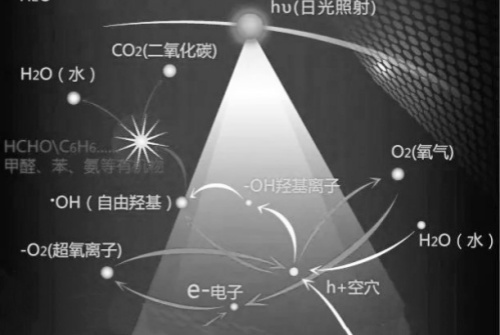In 1972, Japanese scholars found that anatase nano titanium dioxide particles can make water continue to photolysis hydrogen and oxygen under ultraviolet irradiation, since then the semiconductor photocatalyst such as titanium dioxide has become a research hotspot in the field of environmental science in the past 30 years. Photocatalytic oxidation is a new oxidation treatment technology. Due to its high catalytic activity, chemical stability, non-selective degradation of organic matter and other advantages, it has played an important role in environmental governance. Now the use of nano titanium dioxide photocatalytic technology to degrade harmful gases in the atmosphere, purify indoor air, sterilization and deodorization, degrade organic sewage, treat urban garbage, etc., has achieved good results.
Nano-titanium dioxide has the characteristics of small size effect, high specific surface effect and high chemical activity of nanomaterials, and has high photocatalytic performance. Nano titanium dioxide is favored because of its low price, suitable band gap width, large specific surface area, high chemical stability, strong REDOX ability, no secondary pollution and reusable.
Nano titania is widely used in environmental protection, but due to its narrow conduction band width and easy electron-hole recombination, the photocatalytic activity of Ti02 needs to be improved. The photocatalytic activity of TiO2 can be improved by doping transition metal elements, loading, co-catalysis and surface treatment.
Some scholars doped titanium dioxide mass fraction 0.05% Fe catalytic activity than the use of pure titanium dioxide degradation rate increased by 1.36 times; The photocatalytic reduction of organic matter in gasoline reached 98% when the content of iron in tio2 was 0.1660%, while the H2S degradation rate was increased by 63% when the titanium dioxide catalyst was doped with alum under the same conditions.

Some studies indicated that the photocatalytic degradation of phenol by using bamboo charcoal supported titanium dioxide significantly increased the degradation rate. The magnetic suspension supported catalyst made of Fe as magnetic carrier with nano-titanium dioxide composite powder has not only the high efficiency of suspended photocatalyst but also the advantage of its magnetic properties to overcome the difficult recovery of suspended catalyst. The addition of photosensitizer can improve the utilization rate of light energy of TiO2, and the heat treatment of TiO2 with reducing gas can produce more Ti3+ on its surface. A suitable proportional structure of titanium hydroxyl group and Ti3+ is formed on the surface of TiO2, which promotes the effective separation of electrons and holes and the interfacial charge transfer, thus improving the photocatalytic activity.
With the development of photocatalysis technology and nano TiO2 technology, nano TiO2 has been widely used in various fields of environmental protection.
Post time: Feb-28-2024


